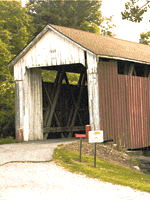

ROCKDALE -- The wooden fibers of the covered bridge humas rubber tires roll over with their smooth planks, but the bridge maynot be a part of the highway system much longer.
The Snow Hill Covered Bridge, located in southeasternFranklin County, was recently placed on the Top Ten Most Endangered IndianaLandmarks list. Compiled by the Historic Landmarks Foundation of Indiana,the list has been in existence since 1991.
In 1996, the bridge was earmarked as troubled during thecounty bridge inspection. Another bridge, near the covered bridge locatedon Johnson's Fork, was also marked for extensive rehabilitation. Commissionersand engineers decided to construct two new cement structures over the areas.
The commissioners said Snow Hill Covered Bridge wouldbe bypassed and not utilized.
Commissioners said they would like to dedicate the coveredbridge to a local historic society and possibly turn the area into a park.They say they have no intention of demolishing the bridge.
Sue Ferris of West Harrison is a fervent believer in thecharm of the old covered bridge and its weathered sideboards and fadinggraffiti. Tucked away in thickly wooded hills, the bridge is a reminderof days when the only bridges in the county were covered.
Inside the bridge, the air is cool and damp. In severalareas, the floorboarding has parted just enough to allow a view of muddywater below. The playbills once tacked to the outside are long gone,but graffiti decorates
the inside and old beer bottles are stashed between thewalls and floorboards.
Ferris said a recent brochure advertising a subdivisionin the area has a photo of the bridge on the cover, enticing home buyers.
"To me, it's not in that bad of a condition," she said."We're losing something so wonderful."
Commissioners also cited recent population growth in thearea as a reason to replace the one-lane wooden structure with a two-lanebridge.
Ferris said the area is not booming with a populationready to demolish the bridge. In fact, she said neighbors would like tosee it stay. She said many residents enjoy the charm the bridge adds tothe community.
"To me, we have not outgrown this bridge," she said. "Itis a monument to our forefathers. It's part of Indiana history."
Ferris said she wants the bridge rehabilitated. She saidthe county receives $1,200 from the state dedicated to each of the twowooden bridges Franklin County boasts. The other, the Enochsburg CoveredBridge, is located in Ray Township.
Commissioners said $1,200 is not enough to fund the extensiverehabilitation the bridge needs.
Ferris also objects to the commissioners' idea of a park.She said neither the Franklin County Historic Preservation Board nor theFranklin County Historical Society can afford to pay for maintenance ofthe bridge. She also said neighbors in the area object to a park.
Franklin County Commissioner Bob Brack said the constructionwill not occur for at least five years, the time needed for engineering,land acquisition, surveys and grant applications.

"Covered bridges have been the locale of weddings, churchsuppers, band concerts and memorable bare-knuckle fist fights. On the darkerside, the bridges have been figured in murders, suicides and lynching parties,"wrote Richard Sanders Allen in "Covered Bridges of the Middle West."
According to Allen, the bridge's roof and weatherboardingwas not for the protection of travelers, horses or even sweethearts seekingquiet, dark places.
The coverings were to keep the main structural timbersof the bridge dry. The timbers would quickly rot if exposed to Midwesternsun, rain and dampness.
Most were made of raw wood and had shingled roofs. Theywere just wide enough to allow vehicles to pass through single file. Theyserved as a communication center and the exteriors were coated with postersand playbills, announcing sales, circuses and other events.
Franklin County was once the home of many covered bridges,but floods, age and arsonists have left only two: The Enochsburg CoveredBridge in southwestern Franklin County and the Snow Hill Covered Bridgein the southeastern portion of the county.